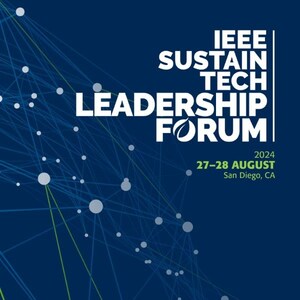LOS ALAMITOS, Calif., Nov. 26, 2019 /PRNewswire/ -- Today, the IEEE Computer Society (IEEE CS) reveals the end-of-the-year scorecard for its 2019 technology predictions which forecasted deep learning accelerators, assisted transportation, and the Internet of Bodies (IoB), to lead the 2019 technology outlook. Looking back on its 2019 predictions, the scorecard grades the IEEE CS's successes and shortcomings on its future view, along with analysis of the progress and potential of each predicted technology. The overall score for the 2019 technology predictions is a solid B.
"The past year has seen tremendous growth in deep learning accelerators and continued increase in the adoption of assisted transportation and augmented/virtual reality," said Dejan Milojicic, IEEE CS past president (2014). "We have seen a substantial jump in technology innovation this year, leading to our promising technology predictions for 2020, so stay tuned for more from the IEEE Computer Society."
Following are the IEEE Computer Society predictions, grades, and analysis:
Technology |
Comparison |
|
How Well We |
Explanation |
|
Deep learning accelerators |
A |
Deep learning (DL) accelerators have made a substantial advance through many startups and products already on the market. This is very consistent with DL advances from previous years as well as our prediction. It was the only single prediction that received straight A's, including three A+'s, resulting in an average A overall. |
Assisted transportation |
A/B |
This is the second top ranked prediction, with all A and B evaluations. In many ways this prediction is supported by the previous technology on accelerators for DL. Many vehicles depend on video and image recognition which are enabled by accelerators. While the full autonomous vehicle vision is still in the works, many features are being deployed as assisted functionality. Substantial assistance is being directly deployed, such as alerts for proximity to other vehicles, obstacles, the edge of roads, parking, and objects around car. |
The Internet of Bodies (IoB) |
B/C |
The movement of the Internet of Things into the IoB continues to progress below the radar of most people. This year, the FDA issued security advisories for internet-connected medical devices with security issues, and some companies announced their intention to conduct human trials for brain implants with read/write capability connected to the cloud in 2020. Employers and schools expanded their use of technologies such as brain-sensing headbands to (allegedly) track attention and other wearable devices. AR and VR headsets gained in popularity and applications expanded. As human bodies become more reliant on the internet for their functionality and safety, these attached or implanted devices used for medical purposes, employment monitoring, and recreation, will continue to gain prominence. They will also raise complex ethical and legal questions. |
Social credit algorithms |
B- |
Social credit algorithms are largely developed away from the public's attention because of the potential privacy and freedom breaches they represent, but detailed data is required on entire populations to be effective and we are witnessing the increased collection of identifying and behavioral data at country scales. (In recent years many governments, including some democracies, have increased regulations that are designed to more clearly disambiguate the identities of people, such as the full-face mask ban in Hong Kong and the Real ID requirements in the US.) By associating massive behavioral data with uniquely identifiable persons, large companies and governments can build detailed "social credit" and similar measures of virtually every person in their charge. |
Advanced (smart) materials and devices |
B/C |
Many of these technologies appear in small, local experimental settings, but have not received wide distribution. For example, smart road materials that change properties based on light and temperature have already been demonstrated in several countries. Smart pills that allow for the tracking of medications as they travel through the body have been reported in small scale studies, but are not yet available to the public. A wide range of interactive media, such as paper and glass, are available for experimentation and in novelty items, but not in widespread industrial grade or consumer uses. |
Active security protection |
B- |
While active security protection still seems like a good idea, it appears that most of the security mechanisms are still reactive. As viruses become more sophisticated, antivirus companies suggest enhancing the protection mechanisms and making them active. The notion of NGAV (Next Generation of Antiviruses) was generated to indicate a more dynamic approach; e.g., NGAV should be able to "strike-back" or even "strike-first" in the case of attack. This year, different companies have announced new products that can be considered NGAV. We believe that this trend will continue and will become even more significant in the future. |
Augmented reality (AR) and virtual reality (VR) |
B+ |
Market adoption of VR hardware and content continues to grow steadily, while new headsets are developed with incremental improvements. Behind the scenes, these improvements hint at a potential quantum leap in VR: fully immersive, untethered experience. (For example, inside-out cameras eliminate the need for a fixed-space configuration—opening the door to AR/VR integration, and the upcoming tethering of the Quest headset allows for richer VR experiences to be played on the relatively weak mobile headset.) If such tethering is later replaced by a wireless interface, it would completely bridge the gap between the high-quality PC-based VR experience, and the mobility and freedom of the portable AR/VR experience. |
Chatbots |
B |
Chatbots are a reality today, with a market value exceeding $1.5B in 2019 and expected growth to over $7.5B by 2024 with a CAGR of 34% (according to Mordor Intelligence.) The quick uptake is fueled by growing data availability that in turn fuels Artificial Intelligence-based services. The recent progress in Natural Language Recognition and the quality in Speech Syntheses are making chatbot interaction seamless. In the next decade, we can expect an extension of chatbot interaction capabilities to include follow up with clients using different channels. They will also transform from being a grown-up Interactive Voice Response (IVR) to more of an avatar of a service/company interacting and "doing business" with clients. |
Automated voice spam (robocall) prevention |
C |
Our prediction about dramatically improved robocall prevention was based on increasing deployment of features such as call screening, available on recent Google Pixel platforms, in which users can intercept an incoming call with a voice prompt that requires the caller to explain who they are. Indeed, this can be useful (and anecdotally, one user finds that about 90% of calls from unknown callers terminate as soon as the challenge is issued, while legitimate calls can be completed.) However, we expected more—not only additional platforms but better automation. In the future, we may see the ability to automatically challenge unknown callers; by the time the call is put through to the owner of the phone, it is annotated with improved information. |
Technology for humanity (specifically machine learning) |
B/C |
This looked like an obvious idea a year ago, and it's possible that a few companies, universities, or governments have applied machine learning "under the hood" to a humanitarian pursuit, such as identifying a disease or reducing pollution. Last year, we saw examples such as (1) companies that build "electronic sticks for blind people" aiming at "replacing" the use of guide dogs to allow people to be more flexible; (2) in Japan, robots are helping elderly people be more independent; and (3) quite a few advanced, dedicated medical tools that aim to help ill and elderly people to identify when they get lost, and identify and report when they fall. We believe that the grade is relatively low since we are just at the beginning of the revolution—but the revolution has already started and it will improve the quality of life for many people in the near future. |
Overall Score |
B |
We seem to have succeeded in most of our predictions, although we missed some. Overall, it's not a bad score. |
The process followed for ranking the predictions was simple and straightforward, and the authors who originally made the predictions evaluated their predictions individually. Averages and standard deviations were used as a basis for the discussion, which eventually resulted in the final rating.
The authors' overall rating for all 2019 predictions resulted in a score of B which was the same as 2018 and a close runner-up to the 2017 technology predictions score of A-.
Predictions and the scorecard were delivered by Erik DeBenedictis, Stealth Startup; Zoran Dimitrijevic, AirBnB Labs; Fred Douglis, Perspecta Labs; Paolo Faraboschi, Hewlett Packard Labs; Eitan Frachtenberg, data scientist; Phil Laplante, Penn State; Andrea Matwyshyn, Penn State Law - University Park; Avi Mendelson, Technion Israel and NTU Singapore; Dejan Milojicic, Hewlett Packard Labs; and Robert Saracco, IEEE Future Directions Committee. The technical contributors for this document are available for interviews.
Watch for IEEE Computer Society's 2020 technology predictions to be published in Computer magazine's December issue. Sign up here for exclusive access.
For past predictions and scorecards, visit the Press Room for the history of our annual Technology Predictions and Grades.
About the IEEE Computer Society
The IEEE Computer Society, a not-for-profit organization, is the world's home for computer science, engineering, and technology. A global leader in providing access to computer science research, analysis, and information, the IEEE Computer Society offers a comprehensive array of unmatched products, services, and opportunities for individuals at all stages of their professional career. Known as the premier organization that empowers the people who drive technology, its unparalleled resources include, international conferences, peer-reviewed publications, a unique digital library, standards, and training programs. Visit www.computer.org for more information.
SOURCE IEEE Computer Society

Related Links
WANT YOUR COMPANY'S NEWS FEATURED ON PRNEWSWIRE.COM?
Newsrooms &
Influencers
Digital Media
Outlets
Journalists
Opted In





Share this article